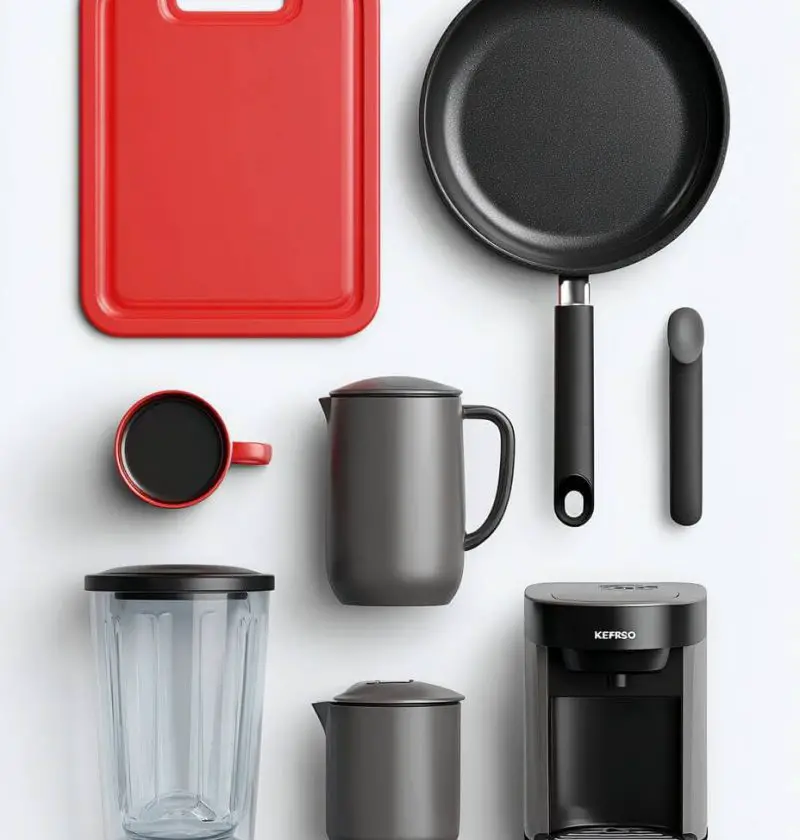Save This Recipe
I’ve spent the better part of my fifty-odd years flitting between stovetop and sink—singing along to Fleetwood Mac, sneaking cookie dough, and hollering “Dinner’s ready!” down the hallway. The kitchen is my comfort zone. Yet even in this sanctuary, a few everyday items quietly misbehave.
Now I’m no fear-monger—life’s too short for that. But a pinch of knowledge sprinkled over our routines can protect the people we love. So let’s chat, neighbor-to-neighbor, about the sneaky hazards hiding in plain sight. Bring your favorite mug; I’ll keep the coffee flowing.
Non-Stick Pans: Convenience with a Catch
Remember the first time you flipped a perfect omelet on slick, shiny Teflon? I felt like Julia Child. But here’s the rub: that coating—polytetrafluoroethylene, if you want the science term—starts breaking down when the pan gets hotter than 500 °F. The invisible fumes can trigger “Teflon flu,” leaving you achy and headachy for a day or two.
Worse, older pans were made with PFOA, which researchers have linked to cancer and developmental woes. Newer “PFOA-free” labels help, but I’ve switched to cast iron for most jobs. Sure, cast iron needs a little love (season it, dry it well), yet it rewards you with perfect sears and a bonus bicep workout. Stainless steel is another sturdy friend; just preheat it properly and food sticks far less than folks fear.
Quick tip: If your non-stick pan resembles a road map of scratches, thank it for its service and retire it. Patching a pan with peeling spots is like slapping a Band-Aid on a sinking boat—it looks helpful, but trouble keeps bubbling through.
Plastic Cutting Boards: The Groovy Bacteria Hide-out
I used to stack rainbow-colored plastic boards like playing cards. They’re cheap, dishwasher-safe, and bright enough to cheer up Monday night prep. But every knife stroke carves a tiny canyon where bacteria settle in and throw block parties—especially after raw chicken night.
Another worry: many low-cost boards contain BPA or phthalates, compounds that mimic hormones and scramble our endocrine systems. Wood and bamboo, on the other hand, have natural antimicrobial powers. Their grain absorbs moisture then quickly starves bacteria of water, leaving germs high and dry.
Oil-and-tell: Rub your wooden board with food-grade mineral oil once a month. It’ll stay smooth, resist splintering, and look handsome enough to double as a cheese platter at book club.
That Beloved Brita Pitcher: Friend or Frenemy?
I adore our countertop filter—my grandkids call it the “magic water jug.” But if you forget to swap the cartridge on schedule, the charcoal inside becomes a cozy home for microbes. Plus, basic pitchers capture chlorines and a few common nasties yet miss heavy metals like lead.
If your tap water comes from older pipes or you live in a century-old farmhouse like mine, consider upgrading to an under-sink system with an NSF certification for lead and arsenic removal. It’s pricier up front, but peace of mind tastes pretty sweet.
Keurig Coffee Makers: A Hot Cup, with a Dash of Plastic
Confession time: the promise of one-button coffee lured me years ago—especially on bleary weekday mornings. But the long, warm soak inside that plastic reservoir encourages microbe growth, and hot water can leach chemicals such as BPA into your brew.
Single-use pods also leave a mountain of waste. Even if you recycle the aluminum top, the plastic shell often winds up in landfills. Lately I’ve been using a French press. Five minutes of steeping, a gentle plunge, and voilà—rich flavor, zero pods. Plus the press looks downright Parisian on the breakfast table.
Aluminum Foil: Handy Helper or Health Question Mark?
Foil is a kitchen superhero for covering casseroles and wrapping garlic bread. But at high oven temps, a smidge of aluminum migrates into acidic or salty foods—think tomato sauce or marinated fish. Some studies hint that elevated aluminum intake may nudge us toward neurodegenerative troubles later in life (scientists are still debating specifics).
Easy workaround: line your foil with parchment before those saucy bakes, or slide your meal into a glass dish with a lid. You’ll slash cling-factor and feel a little fancier, too.
Plastic Takeout Tubs: Leftover Legends, Microwave Menaces
If your fridge looks like a rainbow of deli containers (guilty as charged), you might be microwaving estrogen-mimicking chemicals right into Tuesday’s chili. Heat accelerates how quickly BPA and phthalates seep into food—especially anything oily.
Glass containers solve nearly every complaint: they’re stackable, stain-resistant, and safe for ovens. I nabbed a set during a holiday sale, and they’ve outlived three fridge clean-outs and one dramatic lasagna explosion.
Canned Goods: Shelf-Stable with a Side of BPA
Those cans of chickpeas save my tail on meatless Mondays. Yet many cans are lined with an epoxy containing—you guessed it—BPA. It keeps metal from rusting, but some of that chemical slips into the beans. Look for “BPA-free lining” labels, or grab chickpeas in jars or tetra packs. Better yet, cook dried beans in a slow cooker overnight. Your house will smell cozy, and you’ll feel like a pioneer (minus the prairie hardships).
Spray-Bottle Shockers Under the Sink
Lemon-fresh cleaner sounds wholesome, but flip the label and you’ll find ammonia, chlorine bleach, and “fragrance” (a catch-all word for hundreds of unlisted chemicals). Even mild exposure can irritate lungs and skin—ask anyone who’s coughed their way through bathroom scrub-downs.
I mix a solution of equal parts vinegar and water, plus a drop of castile soap. Add a few drops of lavender oil if sniffing vinegar makes your nose wrinkle. For burnt-on gunk, baking soda works wonders—sprinkle, spritz with water, wait ten minutes, then scrub. My grandkids call it “kitchen fairy dust.”
Artificial Sweeteners: The Plot Thickens
Yellow, pink, blue packets—each claims zero calories, yet studies show they might nudge our gut microbes off balance or intensify cravings for sugary treats. I noticed that after a diet soda, I’d prowl the pantry for chocolate chips. Coincidence? Maybe. Maybe not.
Nowadays I drizzle a teaspoon of maple syrup into oatmeal or swirl local honey into iced tea. Real flavors satisfy faster, and I end up using less overall. Funny how Grandma’s wisdom circles back around.
A Little Recap—Because Lists Help Busy Minds
-
Swap beat-up non-stick pans for cast iron or stainless steel
-
Choose wooden or bamboo boards; oil them monthly
-
Replace filter cartridges on time (set a phone reminder)
-
Consider a French press or pour-over instead of pod machines
-
Use parchment as a buffer with foil, or reach for glass bakeware
-
Store leftovers in glass—skip microwaving plastic
-
Look for BPA-free canned goods or cook from dry
-
Whip up DIY cleaners with vinegar, baking soda, and essential oils
-
Trade artificial packets for small amounts of real sweeteners—or dial back sweetness altogether
Closing Thoughts over a Slice of Peach Pie
If reading this felt like staring down a mile-long to-do list, breathe. Healthy changes don’t happen in one grocery run. I started with a single cast iron skillet from the flea market—ten bucks and a little elbow grease. A month later, I picked up glass containers. Bit by bit, the safer swaps stacked up like quilt squares into a cozy blanket of better habits.
Your kitchen will always be a place of comfort and creativity—that won’t change. We’re simply fine-tuning the tools so the love we pour into meals isn’t diluted by sneaky chemicals.
So, what’s your first swap going to be? Maybe shooting me a message about your beloved wooden spoon that’s older than your youngest kid. I’ll be here, aproned up, singing along to Stevie Nicks, waiting to hear how it goes.
Share this article with a friend who spends more time in the kitchen than on the couch—you might save them from microwaving plastic one more time. And if you have any questions, just holler. I always read the comments between batches of sourdough.

